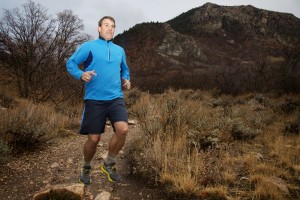
No pain, no gain, as the saying goes, and Eric Johnson isn’t afraid of a little suffering to feed his obsession.
The Ogden resident is a special kind of runner, shunning paved tracks for the uncertainty of the trail, covering long distances, sometimes running days at a time.
He set an ambitious goal last January: to run seven of Utah’s eight 100-mile ultra-marathons in a single year. He made his push a test of self-reliance, too, forgoing aid from the pacers and support crews that usually help ultra-runners.
“To me, it’s about style,” Johnson said. “You can’t get any more cool style than doing a race all on your own. You don’t need any help, and you have multiple levels of expertise that can all come together.”
Beginning in March, the seven races took Johnson along some of the most scenic miles in the state—around Antelope Island, across the Salt Flats, along the rim of Bryce Canyon, around Zion National Park and through the Wasatch Mountains. For the heck of it, Johnson also decided to run an eighth race, just over the Utah border—the Grand Canyon 100-mile.
“I just did that as an extra ‘fun-dred,'” he said, “because I was like, eh, I feel really good, I’m just going to do another.”
Johnson’s real trial in self-reliance came as he ran the historic route of the Pony Express Trail. Johnson and his friend, Chris Anderson, from Mountain Green, decided to run this 100-mile race, the last on Johnson’s list, completely self-sustained. No stopping at aid stations to pick up food stashes, water or extra socks. Instead, he and Anderson pulled modified bike trailers the entire way, loaded with all the water, food and gear he’d need for 27 hours of running.
“I’d never done anything like that, and I’d never seen anyone do it,” Johnson said. “Now I know why. It was seriously one of the hardest things I’ve done, and I’ve done a lot of crazy stuff.”
Ultra-marathons, or endurance races longer than the traditional 26.2-mile marathon, have been in the U.S. since the 1920s, but they’ve had a surge of popularity since the 2000s. The first official 100-mile race came to Utah in 1980 with the Wasatch Front 100, followed by the Logan and Bear Lake-based Bear 100 in 1999. The Pony Express Trail, Zion, Buffalo, Salt Flats, Moab and Bryce 100s came after the year 2000.
According to Johnson, the races offer a unique way to tour the state and appreciate its natural assets.
“After I’ve done all these, I feel more connected to Utah,” he said. “It’s pretty; you’re out. It’s a single-track, dirt road. It’s beautiful. And it’s spiritual.”
Still, there’s no denying traveling 100 miles on foot is punishing. Races usually take runners more than 24 hours to complete with no sleep. Trails run over wild terrain and through capricious weather. Johnson said the most challenging race this year was the Bear 100.
“It rained, so there was tons and tons of mud,” he said. “You’d go up one mountain in the mud, then down the mountain in the mud, then up the mountain in the mud, then down the mountain in the mud.”
Johnson had as little as two weeks between races to rest and heal thrashed feet.
“If you’re not healed, you’d better be committed, because when times get hard, that’s what you’re using for motivation — your commitment level,” he said.
Johnson is no stranger to physical punishment. He ran his first 100-mile race 12 years ago, at age 26, admittedly as a novice.
“I ended up coming in third to last; I had no idea what I was doing,” he said. “I had no gaiters, no headlamp, no trail shoes, nothing.”
Years later, running became Johnson’s passion. He’s now completed 54 100-mile races. He also ran the 350-mile Iditarod Trail in Alaska six times. He admits that signing up for all that punishment takes a special mindset.
“You have to love it. You have to be a little obsessive,” Johnson said. “I know that’s a bad word. But you’ve got to have fun, because otherwise, it’s just too much suffering.”
After wrapping up the Pony Express Trail 100 last October, it was mission accomplished: 800 miles covered throughout the state, plus Arizona. It marked Johnson’s 55th 100-mile finish and the first Utah ultra-marathon race completed by a self-supported athlete (although Johnson shares that title with Anderson).
According to race organizers, Johnson also likely holds the record for the most Utah-hosted 100-mile races completed in a single year. Johnson only missed running the Moab 100, held the day after the Buffalo 100 on Antelope Island.
“I called it the ‘Utah Extreme Seven, Plus One,'” Johnson said, adding the Grand Canyon race.
Anyone looking to match his record will have more race choices in coming years — three more 100-mile Utah races will be held in 2015.
Johnson’s year of extreme running isn’t for everyone, of course, but ultra-marathon running’s popularity keeps climbing. Only two people finished Utah’s first 100-mile race, the Wasatch 100, in 1980. More than three decades later, in 2014, more than 600 runners completed 100-mile races held throughout the state. For ultra-athletes, Johnson said, the drive behind covering a colossal distance, mixed with a copious amount of pain, is no different than any other obsession.
“There’s a common saying in the ultra-running community, ‘For those who understand, no explanation is needed. For those who don’t understand, no explanation will suffice,'” he said. “It can be that way with anything you’re completely passionate about.”




